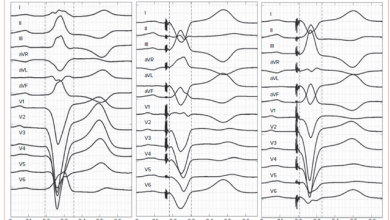Search results
Author(s):
Mark E Josephson
Added:
3 years ago
In patients with syncope or episodes of palpitations and heart disease, an electrophysiology study (EPS) may be of value by means of potential induction of sustained ventricular tachyarrhythmias.1,2 Programmed ventricular stimulation may be useful in the context of risk stratification of ischaemic patients with left ventricular ejection fraction (LVEF) 30–40 %, and there has been some evidence…
View more
Author(s):
Peter H Waddingham
,
Pier D Lambiase
,
Amal Muthumala
,
et al
Added:
2 years ago
Author(s):
Francisco G Cosio
Added:
3 years ago
The term ‘flutter’ was coined to designate the visual and tactile rapid, regular atrial contraction induced by faradic stimulation in animal hearts, in contrast with irregular, vermiform contraction in atrial fibrillation (AF).1,2 On the ECG, flutter was a regular continuous undulation between QRS complexes at a cycle length (CL) of ≤250 ms (≥240 bpm). Slower tachycardias displaying discrete P…
View more
Author(s):
Mark Young Lee
,
Srinath Chilakamarri Yeshwant
,
Sreedivya Chava
,
et al
Added:
3 years ago
Aortic stenosis (AS) is the most common valvular heart disease in industrialised countries with a prevalence of about 5 % in the general population aged greater than 75 years. During the past decade, transcatheter aortic valve replacement (TAVR) has emerged as a valuable, minimally invasive treatment option for patients presenting with symptomatic severe AS, who due to their advanced age and…
View more
Author(s):
Parikshit S Sharma
,
Pugazhendhi Vijayaraman
Added:
3 years ago
Author(s):
Demosthenes G Katritsis
Added:
3 years ago
Since its first description by Hays in England in 1906, second-degree atrioventricular (AV) block has been a fascinating clinical entity, mainly due to obscure points regarding its diagnosis that emanate from misconceptions and errors regarding its proper definition.1–3 The practicing clinician should be aware of the following points that may assist a proper diagnosis and, consequently, accurate…
View more
Author(s):
Igor R Efimov
,
Sharon A George
Added:
3 years ago
Dear Sir,
Thank you for the opportunity to address the reader’s very important question regarding the roles of various connexin isoforms in the complex function of the human AV node.1 These isoforms can serve as a rate-dependent AV conduction axis during normal sinus rhythm or a lifesaving filter of high-frequency excitation produced by atrial tachyarrhythmias or as a backup junctional pacemaker…
View more
Author(s):
Alexandre Raymond-Paquin
,
Santosh K Padala
,
Kenneth A Ellenbogen
Added:
2 years ago
Author(s):
Demosthenes G Katritsis
Added:
3 years ago
The ideal pacing site in the ventricle(s) of patients with atrioventricular (AV) block has been debated for years. Despite considerable technological advances, the optimal ventricular pacing site to mimic normal human ventricular physiology and attain the best haemodynamic response remains elusive.1
Prolonged ventricular dyssynchrony induced by long-term right ventricular (RV) apical pacing is…
View more
Author(s):
Takumi Yamada
,
G Neal Kay
Added:
3 years ago
Idiopathic ventricular arrhythmias (IVAs) usually originate from the specific anatomical structures. For the past decade, major IVA origins from both endocardial and epicardial sites have been increasingly recognised (see Table 1).1–3 Catheter ablation of IVAs is usually safe and highly successful, but can sometimes be challenging because of the anatomical obstacles. Therefore, understanding the…
View more














